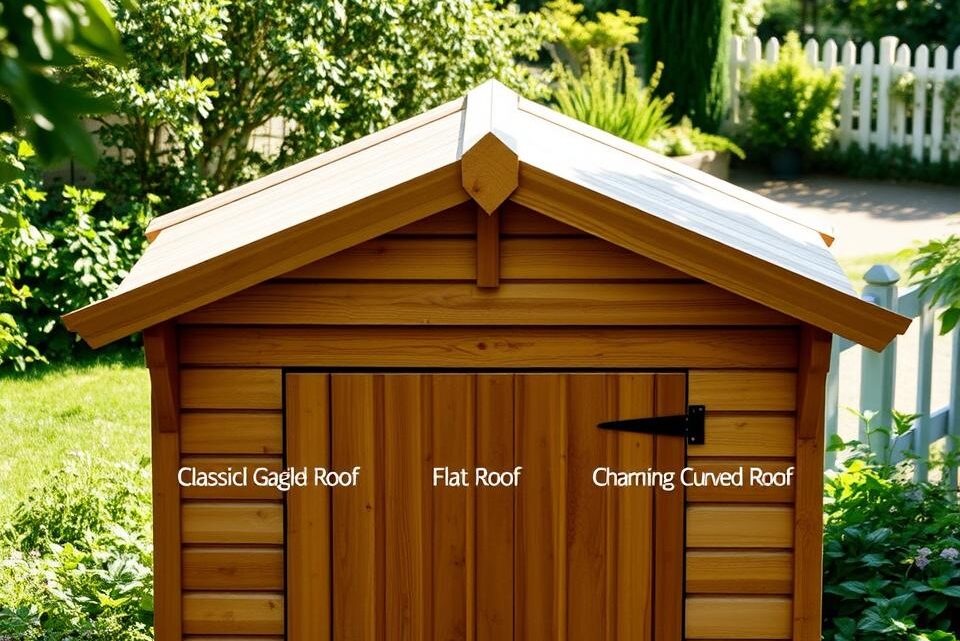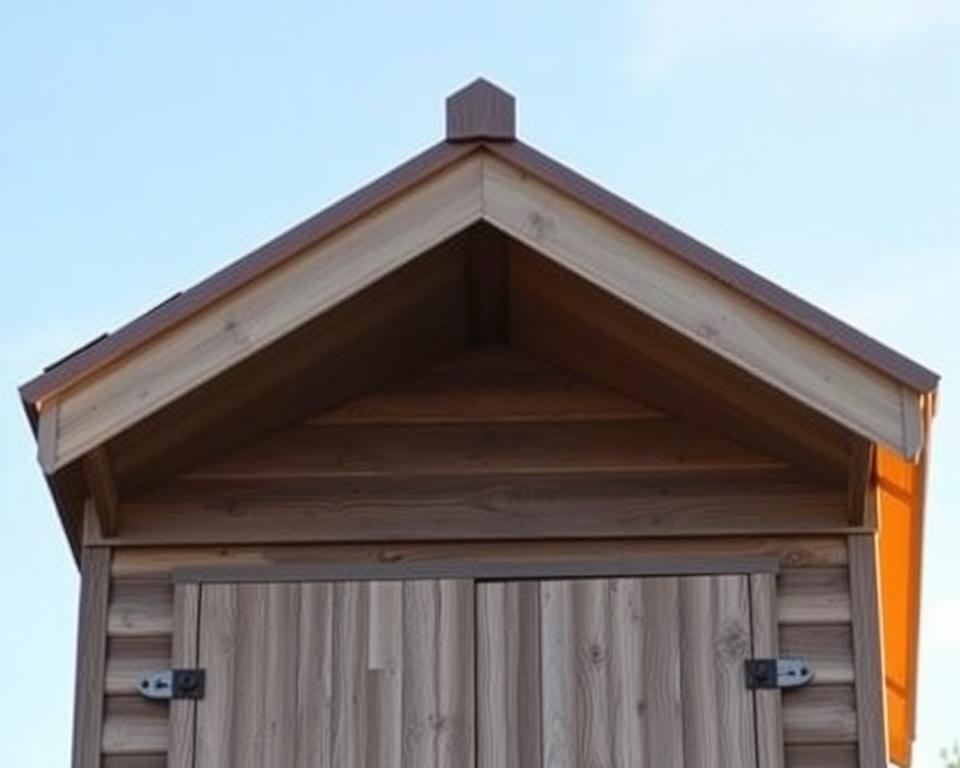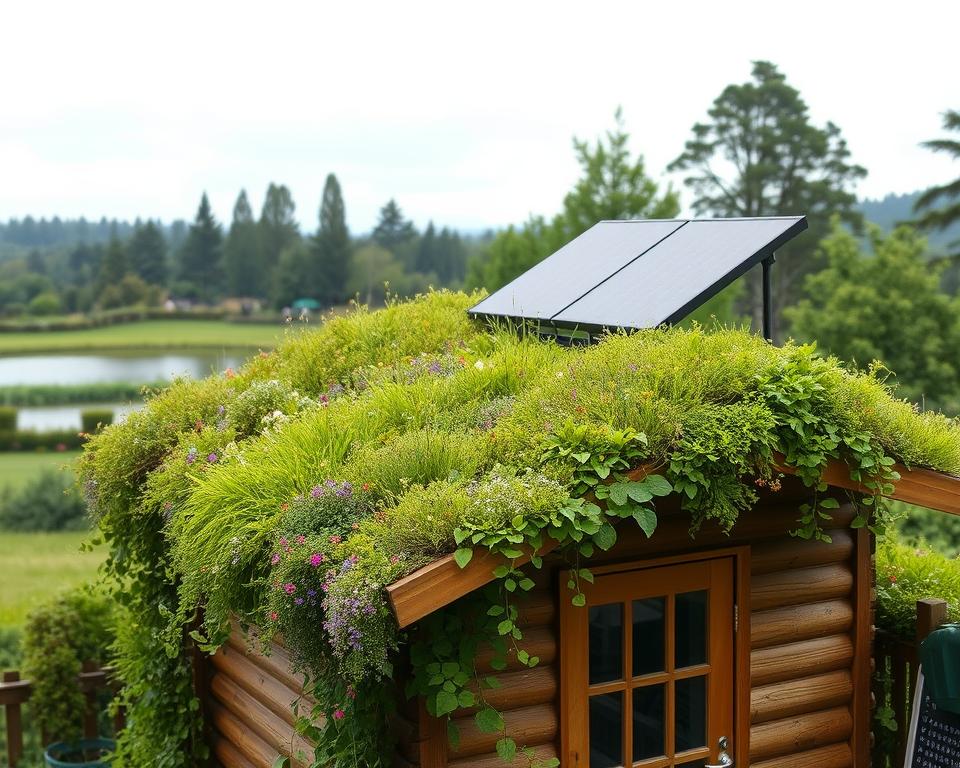Roof Types for Garden Sheds – Pros and Cons Compared

Selecting the right roof for your garden shed is crucial for protecting your valuable storage space and ensuring long-term durability. Garden shed roofing plays a pivotal role in determining the structure’s overall performance, aesthetic appeal, and resilience against British weather conditions.
A comprehensive shed roof comparison reveals multiple design options that cater to different needs and budgets. Whether you’re storing gardening tools, outdoor equipment, or creating a workshop space, understanding the nuanced characteristics of various roof types will help you make an informed decision.
From traditional apex designs to modern flat roof solutions, each roofing style offers unique benefits and potential challenges. Our guide will explore these options, helping you navigate the complexities of garden shed roofing with confidence and clarity.
Inhaltsverzeichnis
Key Takeaways
- Roof selection impacts shed functionality and longevity
- Different roof types suit varied storage requirements
- Weather resistance is a critical consideration
- Cost and maintenance are essential factors
- Professional consultation can improve decision-making
Understanding Garden Shed Roofing Basics
Navigating the world of shed roof basics requires a solid understanding of roofing terminology and structural elements. Garden sheds are more than simple storage spaces – they’re architectural mini-structures that demand careful planning and knowledge.
Before diving into specific roof designs, gardeners and DIY enthusiasts need to grasp fundamental roofing concepts that ensure durability and functionality.
Essential Roofing Terminology
Mastering shed roof basics starts with understanding key terminology:
- Pitch: The angle or slope of the roof surface
- Eaves: The lower edge of the roof that overhangs the wall
- Fascia: Horizontal board running along the roof’s lower edge
- Ridge: The highest point where roof planes meet
Key Components of Shed Roofs
A well-constructed shed roof comprises several critical components:
| Component | Function |
|---|---|
| Rafters | Structural supports that form the roof’s frame |
| Decking | Plywood or OSB board providing a solid base |
| Underlayment | Waterproof barrier protecting against moisture |
| Roofing Material | Final protective layer (e.g., felt, tiles, metal) |
Important Measurements and Angles
Understanding roof measurements is crucial for proper shed construction. The typical garden shed roof pitch ranges between 15 and 45 degrees, depending on local weather conditions and aesthetic preferences.
- Measure roof pitch using a spirit level and measuring tape
- Consider drainage requirements
- Account for local building regulations
By comprehending these roofing terminology and structural elements, you’ll be better equipped to design or select the perfect garden shed roof for your specific needs.
Popular Shed Roof Materials in the UK Market
Selecting the right roofing material is crucial for garden sheds in the United Kingdom. Different shed roof options offer unique benefits, protecting your outdoor storage space from challenging British weather conditions.
Let’s explore the most popular UK shed roofing materials:
- Felt Roofing: An affordable and traditional choice for garden sheds
- Lightweight and easy to install
- Cost-effective solution
- Suitable for smaller garden structures
- EPDM Rubber Roofing: Modern synthetic material gaining popularity
- Exceptional water resistance
- Long-lasting durability
- Minimal maintenance requirements
- Metal Sheet Roofing: Robust and weather-resistant option
- Excellent protection against rain and wind
- Lightweight aluminium and steel variants
- Ideal for larger garden sheds
When choosing shed roof options, consider factors like budget, climate resilience, and aesthetic preferences. Each material offers distinct advantages for UK garden structures.
Professional installers recommend evaluating your specific requirements before selecting UK shed roofing materials. Factors such as local weather patterns, shed size, and long-term maintenance should guide your decision.
Apex Roof Design: Traditional Choice for Garden Sheds
The apex shed roof represents a quintessential traditional shed roofing style that has been a staple in British garden landscapes for generations. Its distinctive triangular shape offers both aesthetic appeal and practical functionality for homeowners seeking a reliable outdoor storage solution.

Garden shed enthusiasts appreciate the apex roof design for its classic silhouette and numerous practical advantages. This traditional shed roofing approach provides superior water drainage and maximises internal storage space.
Benefits of Apex Roofing
- Excellent water runoff capabilities
- Increased internal headroom
- Classic architectural aesthetic
- Enhanced structural integrity
Installation Requirements
Installing an apex shed roof requires careful planning and precise measurements. Homeowners should consider several critical factors to ensure a successful implementation.
- Accurate site preparation
- Proper timber frame construction
- Robust weatherproofing materials
- Correct roof pitch angle
Cost Considerations
| Roof Material | Average Cost per m² | Durability |
|---|---|---|
| Felt Roofing | £15-£25 | 5-10 years |
| EPDM Rubber | £30-£45 | 20-30 years |
| Bitumen Shingles | £20-£35 | 10-15 years |
Selecting the right apex shed roof involves balancing budget constraints with long-term performance. Professional installation typically ranges from £200 to £600, depending on shed size and complexity.
Pent Roof Solutions: Modern and Practical

The pent shed roof represents a sleek and contemporary approach to garden storage solutions. This modern shed design offers homeowners a streamlined alternative to traditional pitched roofs, creating a minimalist aesthetic that complements contemporary outdoor spaces.
Key advantages of the pent shed roof include:
- Single-slope design maximising vertical space
- Enhanced water drainage capabilities
- Lower construction costs compared to complex roof structures
- Perfect for compact garden environments
Structural characteristics of pent shed roofs make them particularly attractive for urban and suburban gardens. The single-slope configuration allows for optimal rainwater runoff, reducing potential moisture-related issues. Homeowners appreciate the clean lines and practical functionality that these roofs provide.
When considering a pent shed roof, gardeners should evaluate several critical factors:
- Available garden space
- Local weather conditions
- Desired aesthetic design
- Budget constraints
Architectural flexibility remains a standout feature of pent shed roofs. These modern shed designs can be customised to suit various garden layouts, ensuring both functionality and visual appeal.
A well-designed pent shed roof transforms outdoor storage from mundane to magnificent.
Flat Roof Options: Simplicity and Functionality
Flat shed roofs have gained significant popularity among UK garden shed owners seeking a modern and practical roofing solution. These sleek designs offer unique advantages for homeowners looking to maximise their outdoor storage spaces efficiently.

Garden shed owners are increasingly recognising the potential of flat roof designs. The streamlined appearance provides a contemporary aesthetic while delivering practical benefits for various shed configurations.
Waterproofing Requirements
Effective waterproof shed roofing is crucial for flat roof longevity. Modern materials and techniques ensure robust protection against British weather conditions:
- EPDM rubber membranes
- Fibreglass reinforced systems
- Bitumen-based waterproofing
Weight Distribution Factors
Proper weight distribution remains critical for flat shed roof performance. Key considerations include:
- Structural support calculations
- Material density assessments
- Load-bearing capacity evaluations
Maintenance Guidelines
Regular maintenance ensures your flat shed roof remains functional and watertight. Proactive care prevents potential structural issues and extends the roof’s lifespan.
- Inspect seams and edges biannually
- Clear debris regularly
- Check for potential water pooling
Implementing these strategies will help garden shed owners maximise their flat roof investment while maintaining optimal performance throughout changing seasons.
Roof Types for Garden Sheds – Pros and Cons Compared
Selecting the best shed roof type requires careful consideration of multiple factors. Our comprehensive shed roof comparison reveals distinct advantages for different garden structures. Each roof design offers unique benefits tailored to specific needs and environmental conditions.

When evaluating the best shed roof type, gardeners must assess several critical aspects:
- Drainage capabilities
- Structural integrity
- Aesthetic appeal
- Budget constraints
- Local weather patterns
Different roof styles present unique characteristics that impact their performance and suitability for various garden environments.
| Roof Type | Pros | Cons |
|---|---|---|
| Apex Roof | Excellent water drainage | Higher construction costs |
| Pent Roof | Modern design | Limited headroom |
| Flat Roof | Simple installation | Potential water pooling |
Professional tip: Always consider your specific garden requirements when selecting a shed roof design.
Understanding these nuanced differences enables homeowners to make informed decisions about their garden shed roofing, ensuring optimal functionality and aesthetic harmony with their outdoor space.
Environmental Considerations in Shed Roofing
Garden shed owners increasingly seek sustainable solutions that minimise environmental impact. The world of eco-friendly shed roof design has expanded dramatically, offering innovative approaches to reducing carbon footprints while maintaining aesthetic appeal.

Modern sustainable roofing options provide garden shed owners with multiple environmentally conscious choices. These solutions go beyond traditional materials, focusing on reducing waste and improving energy efficiency.
Eco-friendly Materials
Selecting sustainable roofing materials can significantly reduce environmental impact. Key eco-friendly options include:
- Recycled plastic roof tiles
- Reclaimed metal sheeting
- Bamboo-based roofing materials
- Rubber recycled from tyres
Energy Efficiency Aspects
An eco-friendly shed roof can dramatically improve overall energy performance. Reflective coatings and proper insulation help regulate temperature, reducing heat absorption during summer and heat loss in winter.
Sustainability Features
Innovative shed roof designs now incorporate advanced sustainability features. Rainwater harvesting systems integrated directly into roof structures allow gardeners to collect and reuse water efficiently.
- Solar panel compatibility
- Green roof options with plant coverage
- Thermal regulation capabilities
Investing in an eco-friendly shed roof represents a forward-thinking approach to garden structure design, balancing environmental responsibility with practical functionality.
Cost Analysis of Different Shed Roof Types
Understanding shed roof costs is crucial for homeowners planning their roofing budget. Different roof types come with varying price points and long-term financial implications that can significantly impact your garden shed project.
When considering shed roof costs, several key factors influence the overall expense:
- Material selection
- Roof complexity
- Installation requirements
- Long-term maintenance
Typical roofing budget ranges for garden sheds in the UK can vary widely. A basic felt roof might cost between £100-£300, while more advanced options like metal or fibreglass can range from £400-£800.
| Roof Type | Initial Cost | Maintenance Cost |
|---|---|---|
| Felt Roof | £100-£300 | Low |
| Metal Roof | £400-£600 | Very Low |
| Fibreglass Roof | £500-£800 | Minimal |
Budget-conscious homeowners should consider not just initial shed roof costs but also long-term durability. Investing in quality materials can reduce future repair expenses.
Professional installation typically adds 20-40% to your roofing budget, so factor this into your overall financial planning for your garden shed project.
Maintenance Requirements and Longevity
Proper shed roof maintenance is crucial for extending the roof lifespan and protecting your garden shed from potential damage. Regular care and timely interventions can significantly impact the durability and performance of your shed’s roofing system.
Understanding the specific maintenance needs of different roof types helps homeowners prevent costly repairs and ensure long-term structural integrity.
Seasonal Care Tips
- Spring: Inspect for winter damage and clear debris
- Summer: Check for potential heat-related wear
- Autumn: Clean gutters and remove fallen leaves
- Winter: Remove snow accumulation and check for water damage
Common Repair Issues
| Roof Type | Typical Problems | Recommended Action |
|---|---|---|
| Felt Roofing | Tears and punctures | Patch with roofing sealant |
| Metal Roofing | Rust and corrosion | Apply rust-resistant paint |
| Wooden Roofing | Rot and moisture damage | Treat with wood preservative |
Lifespan Expectations
The roof lifespan varies depending on material and maintenance quality. Regular inspections and proactive care can extend your shed roof’s durability significantly.
- Felt roofs: 10-15 years
- Metal roofs: 20-30 years
- Wooden roofs: 15-20 years
Investing time in shed roof maintenance not only protects your structure but also prevents expensive replacements in the future.
Planning Permission and Building Regulations
Navigating shed planning permission and UK building regulations can feel like traversing a complex maze. Understanding these legal requirements is crucial for homeowners looking to add a garden shed to their property.
In most cases, garden sheds fall under permitted development rights. This means you can typically construct a shed without formal planning permission, provided you meet specific criteria:
- The shed must be single-storey
- Maximum height of 2.5 metres
- Located at least 2 metres from property boundaries
- Total floor area less than 15 square metres
UK building regulations become more critical when your shed’s intended use goes beyond simple storage. Structures used as home offices, workshops, or living spaces require more stringent compliance.
| Shed Type | Planning Permission Required | Building Regulations |
|---|---|---|
| Standard Storage Shed | Usually Not Required | Minimal |
| Workshop/Office Shed | Potential Requirement | Full Compliance Needed |
Always check with your local planning authority for specific guidance. Some conservation areas or listed properties have additional restrictions that might impact shed installation.
Professional advice can help you navigate these regulations effectively, ensuring your garden shed project remains compliant and stress-free.
DIY Installation Guide and Professional Options
Deciding between a DIY shed roof project and professional roofing services requires careful consideration. Homeowners can save money by taking on the installation themselves, but professional expertise ensures quality and longevity.
DIY Shed Roof Preparation
Before starting a DIY shed roof project, gather essential tools and materials. Successful DIY shed roof installation demands precision and technical skills.
- Measure roof dimensions accurately
- Select appropriate roofing materials
- Invest in quality safety equipment
- Check local building regulations
Professional Roofing Services: When to Choose Experts
Professional roofing services become crucial for complex roof designs or when specialised skills are required. Expert roofers bring technical knowledge and efficient installation techniques.
| DIY Approach | Professional Services |
|---|---|
| Lower initial cost | Guaranteed workmanship |
| Personal satisfaction | Advanced technical expertise |
| Time-consuming | Faster installation |
When selecting professional roofing services, request multiple quotes and verify credentials. Check online reviews and ask for portfolio examples to ensure quality installation.
Proper roof installation protects your garden shed and extends its lifespan.
Whether choosing DIY shed roof installation or professional roofing services, prioritise quality materials and precise techniques for optimal results.
Conclusion
Choosing the right roof for your garden shed is more than a simple aesthetic decision. Your roof decision guide should prioritise practical considerations such as local climate, budget, and long-term maintenance requirements. Each roof type offers unique benefits that can transform a basic garden structure into a functional and attractive outdoor storage solution.
The best garden shed roof will depend on your specific needs. Apex roofs provide excellent water drainage and traditional charm, while pent roofs offer a sleek modern look with straightforward installation. Flat roofs might suit urban gardens with limited space, presenting a minimalist design that can even support additional features like solar panels or green roofing.
Your final selection should balance durability, cost-effectiveness, and visual appeal. Consider factors like rainfall levels in your region, potential future usage of the shed, and the architectural style of your existing outdoor spaces. With careful planning and the insights shared in this guide, you can confidently select a roof that meets both practical and aesthetic requirements.
Remember that investing time in research and understanding different roofing options will pay dividends in shed longevity and performance. A well-chosen roof not only protects your stored items but also enhances the overall value and functionality of your garden space.
FAQ
What are the most common roof types for garden sheds in the UK?
The most popular roof types in the UK include apex roofs (traditional A-shaped design), pent roofs (single-slope modern style), and flat roofs. Each design offers unique benefits depending on your garden’s size, aesthetic preferences, and functional requirements.
Do I need planning permission for a garden shed roof?
In most cases, garden sheds fall under permitted development rights, but there are specific restrictions. You’ll typically need to ensure the shed is under 2.5 metres in height, covers less than 50% of your garden area, and isn’t located at the front of your property. Always check with your local planning authority for precise local regulations.
Which roofing material is most durable for UK weather conditions?
EPDM rubber and metal sheet roofing are considered highly durable for British weather. These materials offer excellent water resistance, can withstand frequent rain and occasional snow, and provide long-lasting protection against moisture and temperature fluctuations.
How often should I maintain my garden shed roof?
Regular maintenance is crucial. We recommend annual inspections in spring and autumn. Check for any signs of damage, clean gutters, remove debris, and repair minor issues promptly to prevent more significant problems like water ingress or structural damage.
Can I install a green or eco-friendly roof on my garden shed?
Absolutely! Green roofs are becoming increasingly popular in the UK. These living roofs can be installed on flat or slightly pitched surfaces, providing excellent insulation, supporting local biodiversity, and creating an attractive, environmentally friendly feature in your garden.
What roof type is best for a small garden?
For smaller gardens, a pent roof is often ideal. Its single-slope design maximises vertical space, allows for better light penetration, and creates a sleek, modern look that doesn’t overwhelm compact outdoor areas.
How much does a garden shed roof typically cost?
Costs vary widely depending on materials and size. Felt roofing is the most budget-friendly, typically ranging from £50-£150, while more advanced options like EPDM rubber or metal sheeting can cost between £200-£500 for an average garden shed roof.
Are flat roofs suitable for UK climate?
Modern flat roof technologies have significantly improved their suitability for UK conditions. With proper waterproofing and regular maintenance, flat roofs can be an excellent, low-cost option that works well in British weather, especially for modern or minimalist garden designs.

